Snowboarding on Mt. Hood: A Comprehensive Exploration


Intro
Snowboarding on Mt. Hood is not just an exhilarating activity; it is a complex interplay of nature, culture, and sustainability. The mountain itself, a dormant stratovolcano, offers a unique environment for snowboarding enthusiasts. This article opens the door to understanding the diverse aspects of snowboarding at this iconic location in Oregon.
The significance of Mt. Hood extends beyond recreational sports. The mountain's snowboarding terrain is shaped by its geological features and environmental conditions. The experiences shared by individuals and communities here weave into the larger tapestry of snowboarding culture in the region. It is crucial to navigate these themes with care, recognizing the importance of maintaining the ecological balance amidst the joy of winter sports.
Understanding Woodland Ecosystems
The ecosystem surrounding Mt. Hood is vital to both its recreational opportunities and environmental health. Understanding woodland ecosystems serves as a foundation for recognizing the impact of snowboarding and winter sports on the area.
Importance of Biodiversity in Forests
Biodiversity within forest ecosystems contributes to resilience and stability. Diverse species interact in myriad ways, leading to healthier environments that support activities like snowboarding. When forests thrive, they influence the quality of snow, the nature of the terrain, and the experiences available for snowboarders. Protecting biodiversity therefore sustains not only the environment but also the recreational opportunities dependent upon it.
Role of Forests in Climate Regulation
Forests fulfill a critical role in climate regulation. They act as carbon sinks, absorbing CO2 from the atmosphere. This process mitigates the impacts of climate change, which is particularly important in areas like Mt. Hood where winter sports rely on consistent snow conditions. Sustainable management of these forests can thereby enhance both biodiversity and the quality of snowboarding experiences.
In considering the future of snowboarding on Mt. Hood, it is essential to integrate knowledge of these ecosystems into planning and policy decisions. This fusion of recreation and environmental stewardship will ultimately lead to a more sustainable future for the mountain and those who enjoy it.
"The interconnectedness of recreation and conservation is vital to ensure the longevity of our natural landscapes and the sports we cherish."
Sustainable Forestry Practices
Addressing the complexities of snowboarding on Mt. Hood involves an understanding of sustainable forestry practices. Ensuring the health of forests contributes directly to the quality of the snowboarding landscape.
Principles of Sustainable Forestry
Sustainable forestry emphasizes practices that meet current needs without compromising future generations. This can include:
- Selective Logging: Minimizing damage to surrounding trees and ecosystems.
- Reforestation: Planting trees to replace those cut down, preserving biodiversity.
- Monitoring Ecosystems: Regular checks to assess the health of forest areas.
Implementing these principles can mitigate the negative impacts often associated with recreational activities.
Case Studies of Successful Implementations
Analyzing successful instances of sustainable forestry can provide key insights. For example, the Sustainable Forestry Initiative (SFI) demonstrates how effective certification can lead to better forest management. Such models can inspire practices that maintain the ecological integrity of places like Mt. Hood.
Woodland Stewardship Techniques
Effective woodland stewardship techniques are essential for the longevity of snowboarding experiences in the region. Developing comprehensive management plans and conservation strategies can bolster these efforts.
Forest Management Plans
A robust forest management plan incorporates multiple stakeholders: local communities, conservation organizations, and recreational users. These plans should focus on:
- Habitat Protection: Safeguarding areas critical for wildlife and plant species.
- Recreational Accessibility: Balancing the needs for snowboarding with conservation.
- Community Engagement: Involving local voices in decision-making processes.
Conservation Strategies
Developing effective conservation strategies requires ongoing research and adaptation. Techniques like controlled burns and invasive species management support the health of forest ecosystems.
Prologue to Mt. Hood
Understanding Mt. Hood is essential in contextualizing the snowboarding experience it offers. This iconic mountain, rising prominently in Oregon, attracts snowboarding enthusiasts from various backgrounds. Its unique geographical features provide ample terrain for all levels of snowboarders. In addition, the mountain contributes significantly to the local culture and economy, further highlighting its importance to recreation and community.
Snowboarding on Mt. Hood is not just about the sport; it intertwines with the natural environment, historical evolution, and cultural significance of the region. This section will discuss Mt. Hood's geographical features and ecological attributes, which are crucial to grasping the full scope of snowboarding activities here.
Geographical Overview
Mt. Hood is the highest peak in Oregon, standing at 11,240 feet. The mountain is characterized by its volcanic origins, which contribute to the stunning landscapes that snowboarders enjoy. Its prominent position within the Cascade Range establishes it as a significant landmark in the Pacific Northwest.
The mountain's climate features diverse weather patterns, which affect snow conditions throughout the year. Typically, the snowy season begins in early November and lasts until late May. This extended season allows for a variety of snowboarding experiences, ranging from fresh powder to spring conditions early in the summer.
Several ski resorts are located on the mountain, including Timberline Lodge, Skibowl, and Mt. Hood Meadows. Each offers distinct terrain options ranging from beginner slopes to challenging runs, ensuring that every snowboarder can find suitable conditions.
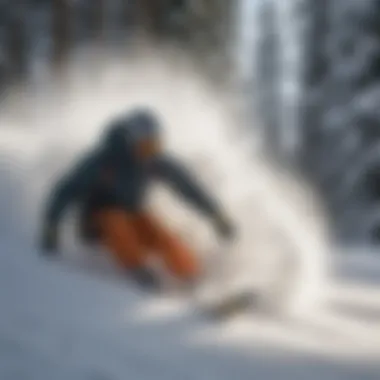
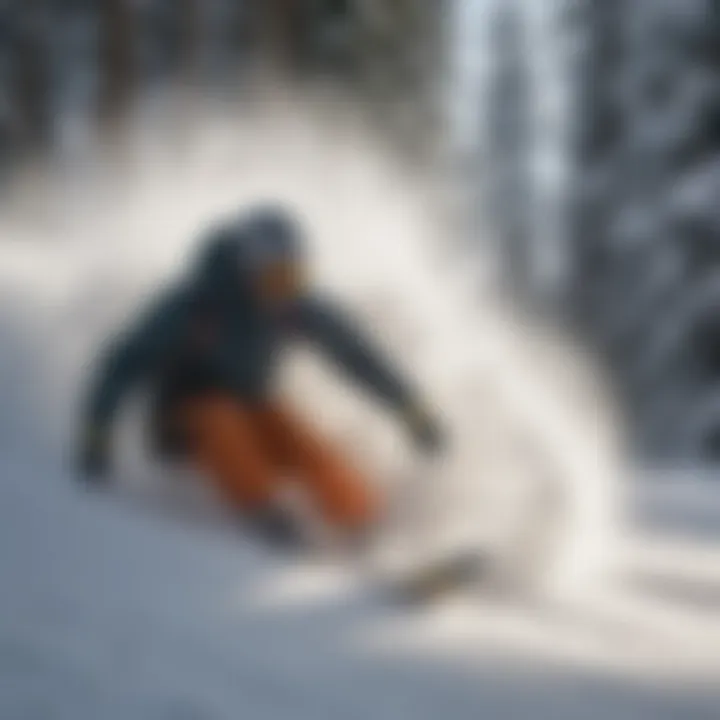
Ecological Significance
Mt. Hood's ecological importance cannot be overlooked. The region is home to several ecosystems, including forests made up of Douglas fir and hemlock, which are vital for wildlife. Maintaining these ecosystems is crucial for the health of the area and supports recreational activities like snowboarding.
Moreover, Mt. Hood has a role in water supply. It feeds rivers and reservoirs, supplying fresh water to nearby communities. Its snowpack acts as a natural reservoir, slowly releasing meltwater and positively impacting local agriculture and wildlife.
The mountain and its ecosystems face challenges, including climate change and increased recreational pressure. Sustainable snowboarding practices are vital for preserving this natural beauty and ensuring future generations can enjoy what Mt. Hood offers.
"The health of our snowboarding environment relies significantly on our stewardship of Mt. Hood's ecosystems."
In the next sections, we will continue exploring the historical context and recreational features that shape the snowboarding experience on Mt. Hood.
History of Snowboarding on Mt. Hood
The history of snowboarding on Mt. Hood is both rich and complex. It reflects not just the evolution of the sport itself but also the changing cultural landscape surrounding winter sports in general. Understanding this history provides valuable insights into the current state of snowboarding, including its challenges and triumphs.
Snowboarding has gained significant attention and traction over the decades, becoming a staple of winter recreation. At Mt. Hood, snowboarding offers an outlet for athletic expression, adventure, and community. Not only does it showcase athletic prowess, but it also brings together diverse groups of people, from casual riders to competitive athletes. The roots of this sport reveal much about human creativity and the drive to innovate in challenging environments.
In examining the history, we uncover specific milestones and cultural shifts that shaped snowboarding on the mountain. These elements enrich our understanding of why Mt. Hood remains a prominent destination for snowboarders. Exploring the origins and key milestones is crucial to grasp how this iconic site has become integral to the snowboarding community.
Origins and Evolution
The origins of snowboarding can be traced back to the 1960s and 1970s. Early enthusiasts, influenced by skateboarding and surfing, began to experiment with ways to navigate the snow. This led to the creation of primitive snowboards, often constructed by hand and lacking the design sophistication of modern equipment. Mt. Hood became a natural venue for these pioneers due to its reliable snowfall and varied terrain.
Initially, snowboarding faced resistance from ski resorts, which often viewed it as a disruptive force. However, as popularity grew, so did acceptance. By the late 1980s, the sport had begun to gain legitimacy, with Mt. Hood playing a pivotal role. The mountain's terrain parks and lifts began to accommodate snowboarders, reflecting a broader acceptance of the sport within winter recreation.
One significant factor in the sport's evolution was the establishment of organized competitions, which further propelled interest and participation. Events hosted at Mt. Hood attracted both local talent and international competitors, contributing to the mountain's reputation as a premier snowboarding location.
Key Milestones
Key milestones in the history of snowboarding on Mt. Hood include:
- The First Official Snowboarding Events: In the early 1990s, Mt. Hood hosted some of the first sanctioned snowboarding events, laying the groundwork for future competitions. These events showcased top athletes and attracted media attention.
- Emergence of Terrain Parks: The introduction of terrain parks at Mt. Hood revolutionized the snowboarding experience. Riders gained access to features designed for tricks, jumps, and creative runs, increasing the sport’s appeal.
- Technological Advancements: The 2000s brought improvements in equipment technology. Enhanced board design and materials improved performance. This allowed riders to push the limits of what was possible on the slopes.
- Youth Involvement: Programs specifically designed for young riders emerged, emphasizing skills and competition. This inclusivity infused new life into the sport and fostered a sense of community among younger athletes.
Snowboarding Terrain Features
The terrain features of Mt. Hood are not just a backdrop for snowboarding; they are integral to the experience itself. Understanding these attributes allows snowboarders to strategically navigate the mountain, enhancing both their enjoyment and safety. With varied parks, trails, and natural obstacles, Mt. Hood provides a dynamic landscape that caters to different skill levels and preferences.
Parks and Trails
Mt. Hood is home to various parks and trails specifically designed for snowboarding. These areas offer unique features that challenge riders and provide opportunities for skill development. The terrain parks include jumps, rails, and other obstacles tailored to freestyle riders. This facilitates creativity and allows for the expression of individual style.
Additionally, the trails range from beginner-friendly slopes to advanced runs, catering to every level of snowboarder. For instance, the Timberline Resort presents trails that wind through picturesque landscapes, encouraging exploration and a connection with nature. This diversity in terrain supports the growth of the snowboarding community, offering spaces for learning and competition alike.
Some notable trails include:
- Palmer Snowfield: Renowned for its expansive area, perfect for both beginners and advanced riders.
- Upper Bowl: Offers steep runs ideal for those seeking an adrenaline rush.
- The Freestyle Park: A hub for park enthusiasts featuring various elements that appeal to creative riders.
Natural Obstacles and Challenges
Natural obstacles on Mt. Hood provide an additional layer of complexity to snowboarding. These can include tree lines, rocks, and uneven terrain. Such features can pose challenges, but they also teach essential skills in maneuverability and risk assessment.
Snowboarders must be aware of their surroundings at all times. Some of these obstacles create opportunities for unique tricks or routes that avoid congested areas. However, awareness is crucial when navigating these features to prevent accidents.
Challenges associated with natural terrain can also vary with the season. Melting snow in spring may expose hidden rocks or other hazards, requiring snowboarders to adapt their skills accordingly. Understanding how these elements change invites riders to be adaptable and enhances their overall experience.
"Natural features challenge snowboarders to think creatively and develop skills that go beyond the basic techniques."
Gear and Equipment
Snowboarding on Mt. Hood requires more than just skills and passion; it demands the right gear and equipment. This section emphasizes the significance of suitable snowboarding gear, covering compositional elements, benefits, and necessary considerations in gear selection. Understanding gear is crucial for both novice and experienced snowboarders. It enhances performance, comfort, and safety, ensuring an enjoyable experience on the slopes.
Essential Gear for Snowboarding
Selecting the essential gear for snowboarding involves understanding various components that help to ensure safety and enhance performance. Here are some of the key items:
- Snowboard: Picking the right snowboard is critical. There are different types designed for varying styles such as freestyle, all-mountain, and powder riding.
- Bindings: Bindings connect the rider to the board. They come in several styles, including strap-on and rear-entry. A correct fit enhances control and stability.
- Boots: Comfort and fit in boots are paramount. Boots should be snug, yet flexible enough to allow movement while providing adequate support.
- Helmet: A helmet is essential for safety. It protects against injuries in falls, which can happen even to the most skilled snowboarders.
- Goggles: Goggles protect the eyes from the bright sun and snow glare, improving visibility on the slopes.
- Apparel: Layering systems consisting of moisture-wicking base layers, insulating mid-layers, and waterproof outer layers are vital to maintain warmth and dryness in cold weather.
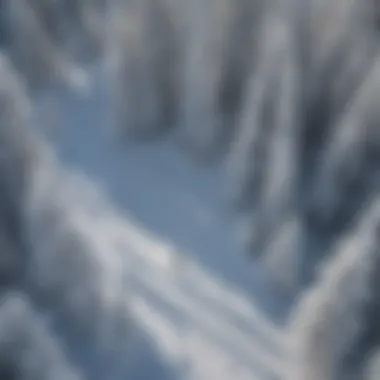

Choosing the proper gear ultimately influences one's performance on the mountain, directly affecting comfort and safety.
Sustainability in Gear Production
Sustainability in gear production becomes increasingly important as the snowboarding community grapples with environmental concerns. The production of snowboarding gear can have significant ecological footprints. Thus, many brands are adopting sustainable practices.
- Materials: Look for brands that use recycled and eco-friendly materials. For instance, some manufacturers create boards with sustainable woods and bio-based plastics.
- Manufacturing Process: A transparent manufacturing process can indicate a commitment to reducing emissions and waste. Brands that prioritize eco-friendly methods lessen their environmental impact.
- Life Cycle: Consider the overall life cycle of gear. Some companies offer repair programs or recycling options to minimize discarded equipment.
"The shift towards sustainability in snowboarding equipment signifies a broader commitment to protect the environments that provide us with these extraordinary experiences."
The movement towards sustainability is not merely a trend; it's an essential evolution in the sport, ensuring that Mt. Hood and similar environments remain pristine for future generations of snowboarders.
Environmental Impact of Snowboarding
Understanding the environmental impact of snowboarding is crucial when exploring recreational activities like those on Mt. Hood. Snowboarding has become a popular winter sport, attracting enthusiasts from diverse backgrounds. However, this rise in activity also brings significant implications for the local ecosystems and natural resources.
When snowboards carve through fresh snow, they not only create thrilling experiences but can also alter the landscape. Thus, it's important to examine both the positive and negative facets of this sport concerning the environment, as well as potential sustainable practices.
Cultural Significance of Snowboarding
Snowboarding represents more than just a recreational activity; it embodies a lifestyle and a cultural phenomenon that resonates deeply within the communities surrounding Mt. Hood. This section examines the profound impact of snowboarding on local identities and the intricate relationships fostered through this sport. The cultural significance cannot be understated. It extends beyond individual enjoyment, playing a crucial role in community cohesion and regional identity.
Community Involvement
The engagement of local communities in snowboarding is multi-faceted. From the early days of the sport on Mt. Hood, community involvement has been essential in developing a vibrant snowboarding scene. Local enthusiasts often organize events, workshops, and competitions that not only showcase talent but also foster community bonds. These gatherings serve as platforms for individuals to connect, exchange knowledge, and celebrate snowboarding culture together.
Snowboarding clubs and organizations contribute to the development of a supportive network. For example, the Mt. Hood Snowboard Association promotes local talent and offers opportunities for collaborative events. These efforts help to nurture a sense of belonging and pride among residents. Additionally, community members often partake in volunteer efforts that support mountain maintenance and safety initiatives.
- Benefits of Community Involvement:
- Enhanced social bonds between members.
- Opportunities for youth engagement.
- Support for local businesses through organized events.
"Snowboarding events have the power to bring people together, fostering both competition and camaraderie in our community."
Through these actions, snowboarding truly becomes a shared experience, integrating recreational enjoyment with the values of cooperation and teamwork.
Influence on Local Identity
The presence of snowboarding on Mt. Hood significantly shapes how residents identify with their environment. It is not merely an activity; it is a defining characteristic of lifestyle for many in the area. For locals, snowboarding symbolizes adventure and resilience, reflecting a dynamic spirit embraced in the community.
Moreover, snowboarding contributes to tourism, attracting visitors from various regions eager to experience the slopes. This influx of tourists influences the local economy and contributes to the cultural narrative of Mt. Hood. Many shops, restaurants, and lodges depend on the seasonal flow of snowboarders, further embedding the sport into the local identity.
- Characteristics of Local Identity Shaped by Snowboarding:
- Emphasis on outdoor recreation.
- Promotion of environmental consciousness.
- Development of unique local traditions and events.
By embracing snowboarding, residents cultivate a collective identity that is intertwined with the mountain’s majestic presence. This shared experience creates opportunities for storytelling and cultural preservation, marking snowboarding as integral to the local heritage.
Events and Competitions
Events and competitions play a vital role in the snowboarding culture on Mt. Hood. They showcase not only the skill of the riders but also the spirit of the community surrounding this winter sport. These gatherings often foster a sense of belonging among participants and spectators alike. They also enhance the visibility of snowboarding to a broader audience, encouraging newcomers to engage with the sport. Furthermore, these events have significant economic impacts, attracting visitors from various places and supporting local businesses.
Annual Snowboarding Competitions
Annual competitions at Mt. Hood attract snowboarders of varying skill levels, from amateurs to seasoned professionals. Events such as the Mt. Hood Spring Snowboard Series and USASA events allow snowboards to compete for titles, showcasing their talent and dedication. These competitions provide a platform for riders to demonstrate performance, technique, and creativity.
Competitions typically feature various disciplines, including slopestyle, halfpipe, and boardercross. Each discipline tests specific skills, which adds depth and variety to the events. This also allows participants to specialize in their chosen areas while pushing their limits. Competitors often train for months leading up to these events, emphasizing the importance of preparation and resilience.
In addition to showcasing talent, these competitions create opportunities for sponsorships and endorsements. Many riders use their performance as a stepping stone to professional careers, further driving interest and investment in snowboarding.
Community Festivals
In addition to formal competitions, community festivals also hold significant importance in the snowboarding scene at Mt. Hood. Events like the Oregon Snowboarding Festival promote not only the sport but also the region's rich culture and connection to the outdoors.
These festivals often feature activities for all ages, including snowboarding clinics, equipment demonstrations, and live music. They serve as platforms for awareness around issues such as environmental conservation and sustainable tourism. Through workshops and informational booths, attendees can learn about responsible practices while enjoying their time on the mountain.
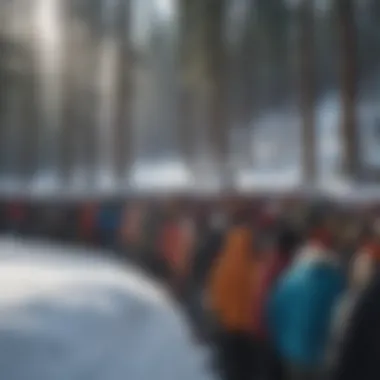
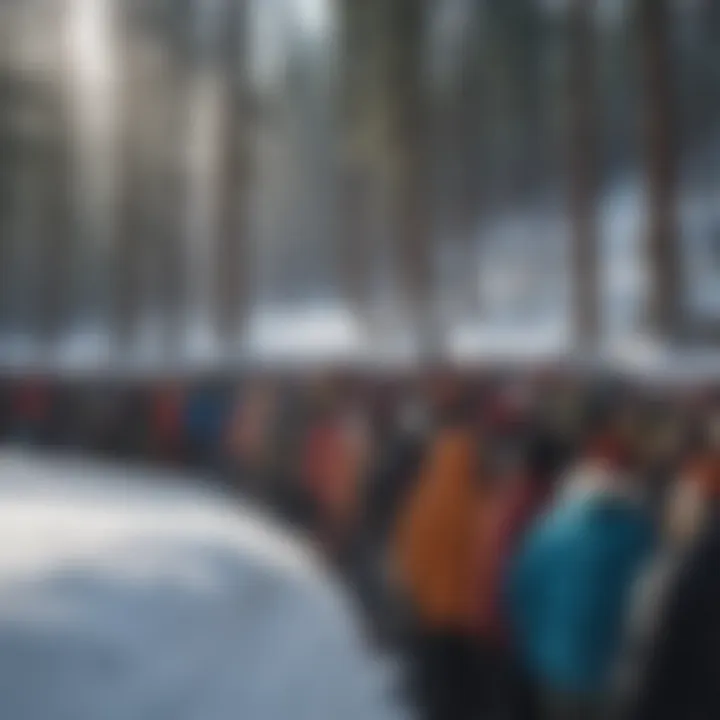
Moreover, festivals include fun competitions that prioritize participation over performance. This inclusivity encourages community engagement and brings families together. These events contribute positively to the social fabric of the region, enriching the experience of both locals and visitors.
Engaging in these festivals helps cultivate respect for the mountain. They remind us that snowboarding is not only about individual performance but about being part of a larger community that values recreation and stewardship.
"Events and festivals not only showcase talent but also breathe life into the community spirit, nurturing a sustainable lifestyle around snowboarding."
With a diverse lineup of events and activities, Mt. Hood continues to foster a vibrant atmosphere for snowboarding enthusiasts.
Safety Considerations
Snowboarding on Mt. Hood offers exhilarating experiences but also presents significant risks. Understanding these risks is critical for both newcomers and seasoned snowboarders. Safety considerations encompass awareness of environmental factors, injury prevention, and emergency preparedness. Proper attention to safety can enhance enjoyment while minimizing accidents and mishaps on the mountain.
Understanding Risks and Precautions
Snowboarding inherently involves various risks. Factors such as weather conditions, terrain features, and personal skill level play a pivotal role in safety. On Mt. Hood, conditions can change rapidly. Visibility may decrease and snow conditions can become unpredictable. This necessitates snowboarders to remain vigilant. Here are some key risks and how to manage them:
- Avalanches: High levels of snow accumulation can lead to avalanches. Snowboarders should understand avalanche signs and stay informed by checking local conditions.
- Falling: Beginner snowboarders can easily fall, particularly when learning new techniques. Wearing proper gear, such as helmets and padded clothing, can minimize the impact of falls.
- Collisions: Areas of popular trails can become congested. Stay aware of other snowboarders and avoid sudden movements that may lead to collisions.
To mitigate these risks, snowboarders should take proactive measures. Enrolling in lessons with experienced instructors can significantly improve skills and confidence. Familiarizing oneself with the terrain map and sticking to marked trails is also important.
Emergency Protocols
Being prepared for emergencies is essential when snowboarding on Mt. Hood. Knowledge of emergency protocols can save lives. Important steps include:
- Have a Plan: Always inform someone of your intended route and expected return time.
- Know Emergency Contacts: Familiarize yourself with the local ski patrol contact information and emergency telephones scattered throughout the resort.
- First Aid Knowledge: Basic knowledge of first aid can be beneficial. Carry a small first aid kit that includes essentials like band-aids, antiseptic wipes, and pain relievers.
- Use of Rescue Beacons: In off-piste areas, using a beacon is advisable. This aids in location during emergencies, particularly in avalanche situations.
In summary, snowboarding on Mt. Hood requires a commitment to safety. Being aware of potential risks and having a clear emergency plan can enhance the experience. Engage in responsible practices that prioritize personal safety while enjoying the thrill of snowboarding.
Future of Snowboarding on Mt. Hood
The future of snowboarding on Mt. Hood is pivotal for both enthusiasts and conservationists alike. As climate patterns shift, understanding the long-term viability of winter sports on this iconic mountain becomes increasingly critical. The implications for both the local economy and the environment are significant.
The balance between thrill-seekers and environmental stewardship shapes the future landscape of snowboarding here. Maintaining access, while ensuring that ecological integrity remains intact, is a complex but necessary endeavor. Collaboration between recreational users and conservation organizations is essential to preserve this unique environment.
Trends in Snowboarding
Snowboarding continues to evolve, influenced by advancements in technology and changing demographics of riders. One trend is the rise of backcountry snowboarding, where riders seek untouched terrain away from crowded slopes. This trend emphasizes the need for understanding safety protocols as well as environmental impact. Additionally, the growth of freestyle snowboarding is notable, as parks and features are designed for tricks and stunts evolve.
Market trends also indicate an increased preference for personalized experiences, including guided tours. Many riders seek more intimate experiences that connect with the mountain's natural beauty, contrasting the often commercialized ski resorts. The demographic shift towards younger, environmentally-conscious riders emphasizes awareness about climate change and sustainability, greatly influencing future practices in the sport.
Sustainability Initiatives
Sustainability initiatives are increasingly relevant as the snowboarding community on Mt. Hood strives to reduce its environmental footprint. Organizations like the Mt. Hood Snowboard Foundation promote eco-friendly practices by partnering with local businesses. These initiatives include:
- Educational Campaigns: Encourage responsible riding practices and promote awareness of the impact of snowboarding on ecosystems.
- Eco-Friendly Facilities: Development projects focus on sustainable materials and energy-efficient designs for lodges and facilities.
- Partnerships with Conservation Groups: Collaborations with groups focused on habitat preservation help mitigate disruptions caused by recreational activities.
The commitment to sustainability is not just about preserving the mountain's beauty; it ensures that future generations can enjoy snowboarding on Mt. Hood.*
Engagement from both riders and local businesses is essential for the success of these initiatives. Involving the community fosters a shared sense of responsibility, vital for ensuring that snowboarding thrives while respecting the delicate balance of the mountain's ecosystem.
In summary, as we look to the future, adapting to trends and implementing sustainable practices will shape the landscape of snowboarding on Mt. Hood. The proactive engagement of all stakeholders involved can lead to a brighter, more sustainable future for this beloved sport.
The End
The experience of snowboarding on Mt. Hood encapsulates not only the thrill of the sport but also a deep connection to land, community, and nature. This article has explored various dimensions of snowboarding on this iconic mountain, emphasizing key factors such as geographical features, historical context, and the cultural significance that snowboarding holds within local communities.
Reflection on Snowboarding Experience
Snowboarding on Mt. Hood is not merely a recreational activity; it is an adventure that immerses participants in breathtaking landscapes and fosters personal growth. Many who partake in this sport often describe their experience as transformative. As they glide down the slopes, surrounded by the rich beauty of nature, snowboarders engage in a dialogue with the environment that goes beyond the physical.
The feelings of exhilaration and freedom that climbing to new heights offers contribute to a deeper appreciation for the mountain's ecosystems. This profound connection encourages individuals to engage in thoughtful reflection on their impact and role in preserving such environments. Whether a novice learning the ropes or an experienced rider tackling challenging trails, each snowboarder forms a unique relationship with the mountain.
The Importance of Stewardship
Stewardship is crucial in maintaining the balance between recreation and conservation. Snowboarding on Mt. Hood inevitably poses certain environmental challenges. Increased foot traffic, potential damage to vegetation, and waste management are significant concerns. Therefore, understanding stewardship in this context becomes vital.
It is important for snowboarders to actively participate in conservation efforts. This includes embracing principles such as Leave No Trace and engaging with local initiatives aimed at preserving the mountain's natural beauty. Community actions, from clean-up events to educational workshops, empower snowboarders to protect the terrains they enjoy.
Ultimately, stewardship is about acknowledging the responsibility to sustain the environments we cherish. As snowboarding continues to grow in popularity, fostering a culture of care and respect for Mt. Hood will ensure that future generations can also enjoy what it has to offer.
"The act of snowboarding is not just about the ride; it's about cultivating a deeper understanding of our connection to the land."
In summary, the conclusion of this article highlights the intricate relationship between the sport of snowboarding, personal experience, and ecological responsibility. As riders navigate the slopes, embracing both the thrill and the duty of stewardship is essential.







